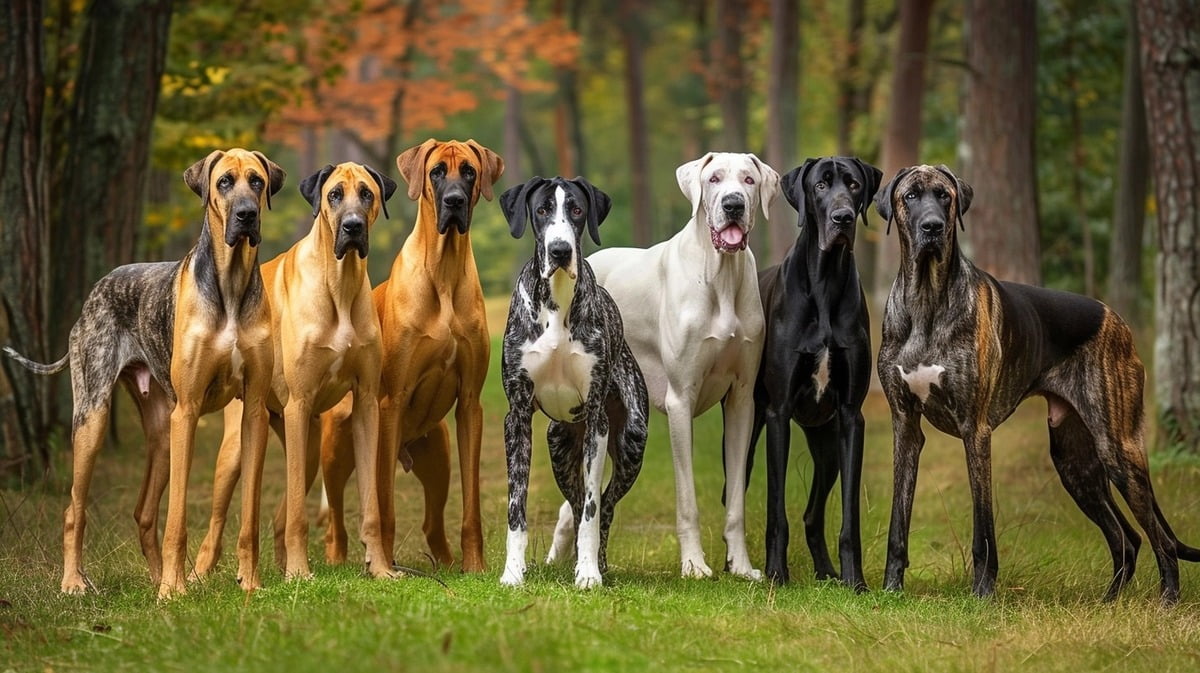Have you ever seen a Great Dane so tall it towers over most people? These gentle giants come in a variety of stunning coat colors, each with its own unique charm. One look at a Harlequin Great Dane with its dramatic black patches on a white coat, and you might feel like you’ve encountered a majestic spotted horse!
Great Danes are more than just stunning looks, though. These loyal companions boast a loving and friendly temperament, making them cherished members of many families. While coat color can certainly be a conversation starter, it’s important to remember that temperament and overall health should be the top priorities when choosing a canine companion.
Did you know that a survey by the Great Dane Club of America revealed that nearly 20% of potential Great Dane owners prioritize coat color as a major factor in their decision? That’s a significant number of people who might be drawn to the breed for its aesthetics, but it’s crucial to go beyond the surface and understand the unique needs and personality of these amazing dogs.
This comprehensive guide will delve into the captivating world of Great Dane coat colors. We’ll explore the officially recognized colors like the sleek black coat and the eye-catching brindle pattern. We’ll also peek into the lesser-known variations like the fawn mantle and the brindlequin. Throughout this journey, we’ll keep in mind that temperament and health are paramount. By the end, you’ll be well-equipped to appreciate the full spectrum of Great Dane beauty, both inside and out!

Great Dane: A Breed Steeped in History
The Great Dane, with its impressive stature and regal presence, boasts a rich history dating back centuries. Their origins can be traced back to German hunting dogs of the Middle Ages, where their size and strength made them formidable companions for nobility in pursuit of wild boar, deer, and even bears!
Coat Colors Through the Ages
It’s believed that the diverse coat colors we see in Great Danes today likely arose from selective breeding practices during this era. For instance, brindle patterns might have been favored for their camouflaging effect in hunting environments.
A Legacy of Grandeur
These magnificent dogs weren’t just prized for their hunting prowess; they also became symbols of status and power among European nobility. Throughout history, Great Danes have graced the castles and estates of prominent figures, further solidifying their reputation as gentle giants with a touch of grandeur.

The Spectrum of Officially Recognized Great Dane Colors
Black Great Danes – Bold and Beautiful
The epitome of elegance, black Great Danes boast a sleek, inky black coat that shimmers in the sunlight. According to the American Kennel Club (AKC) standards, this solid black color should cover the entire body with minimal exceptions. A small amount of white on the chest is acceptable, but any excessive white markings or brindle patterns would disqualify a Great Dane from conformation shows.
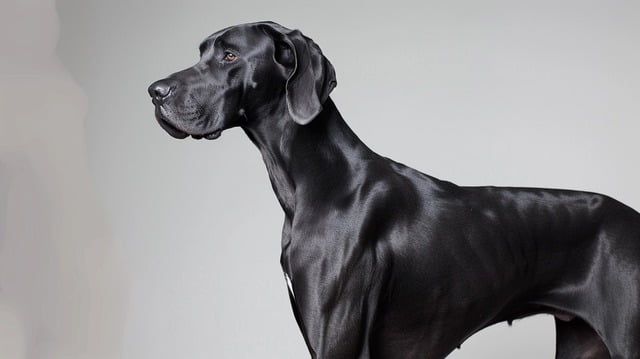
Blue Great Danes – A Touch of Dilution
Blue Great Danes possess a captivating coat that appears like a diluted version of black. This dilution is caused by a specific gene and results in a greyish-blue hue throughout the fur. Similar to black Great Danes, standards require a solid blue coat with minimal white markings acceptable only on the chest. It’s important to note that blue Great Danes may sometimes have black facial features, which adds to their unique charm.
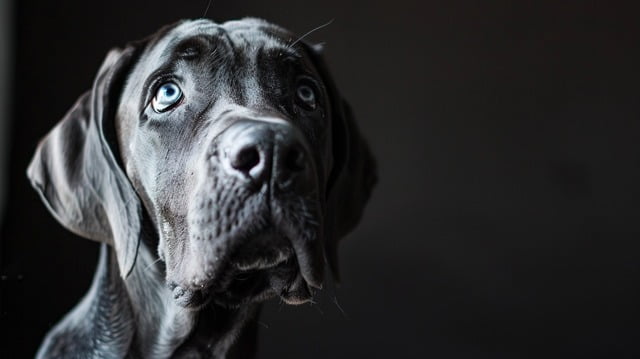
Fawn Great Danes – A Spectrum of Warmth
Fawn Great Danes come in a delightful range of warm tones, from a light fawn to a rich apricot. The AKC recognizes both solid fawn and fawn brindle as acceptable coat colors. Fawn brindle features black stripes on a fawn base, adding a touch of complexity to the overall look. These gentle giants with their warm-hued coats exude a sense of sunshine and cheer.
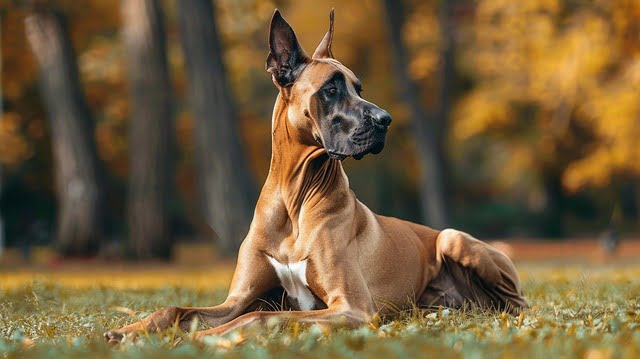
Brindle Great Danes – Stripes of Distinction
Brindle Great Danes are showstoppers with their captivating coat patterns. These patterns consist of black stripes on a fawn, red, or even a blue base color. The AKC allows for a variety of brindle variations, with the stripes ranging from thin and closely spaced to wider and more spaced out. Brindle Great Danes with unique and well-defined stripes are particularly admired for their striking appearance.
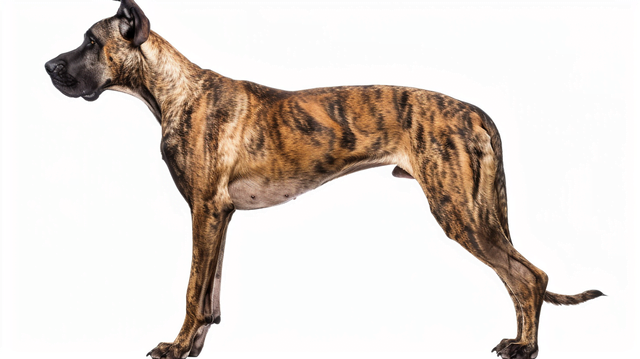
Unveiling the Mystery: The Genetics Behind Fawn and Brindle
The captivating colors of fawn and brindle Great Danes are influenced by specific genes. Fawn coloration is linked to the “E” locus, which controls the production of pheomelanin, a pigment responsible for red and yellow tones. Brindle patterns, on the other hand, are caused by a dominant gene that disrupts the distribution of pigment throughout the fur, resulting in the characteristic stripes.
Harlequin Great Danes – A Masterpiece of Patches
Harlequin Great Danes are undeniably captivating with their striking coat pattern. Imagine a sleek white base adorned with dramatic black patches of irregular shapes and sizes. This unique pattern is what makes Harlequins so sought-after and admired. standards for Harlequins are quite specific, requiring a balanced distribution of black on white with no brindle markings.

Mantle Great Danes – A Touch of Nobility
Mantle Great Danes exude an air of elegance with their distinctive coat pattern. These gentle giants boast a solid base color, typically fawn or brindle, with a black “mantle” that covers their head, neck, and upper body. The AKC standards for mantles require a well-defined dark mantle with a clean separation from the base color. This color combination evokes a sense of regality, making Mantle Great Danes a popular choice for those who admire a touch of grandeur in their canine companions.
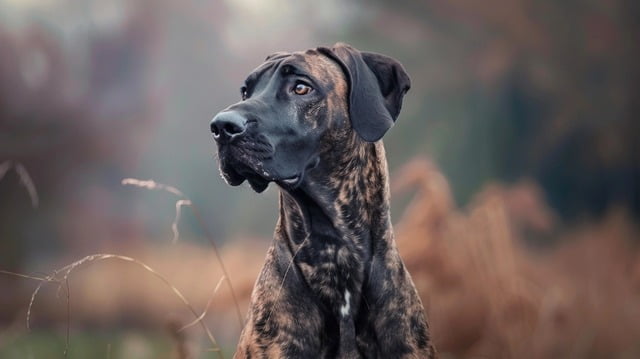
Decoding the Palette: Genetics Behind Great Dane Colors
The captivating array of coat colors in Great Danes is more than just aesthetics; it’s a fascinating story written in the language of genetics. Understanding the genes that influence coat color variations can provide valuable insights into breeding practices and responsible pet ownership. In this section, we’ll delve into the science behind the stunning spectrum of Great Dane colors.
The Language of Genes
Imagine each Great Dane pup inheriting a genetic blueprint from its parents. This blueprint, known as DNA, contains instructions for everything from fur color to eye color. Genes are specific sections of DNA that act like recipes, dictating the traits an animal will inherit. Genes come in pairs, and each parent contributes one gene for each trait. Some genes are dominant, meaning their effect prevails even if paired with a recessive gene. Recessive genes only show their influence if paired with another recessive gene from the other parent. Understanding these basic concepts of dominant and recessive genes is key to unlocking the mystery of Great Dane coat colors.
Decoding Fawn and Brindle: A Case Study
Let’s use fawn and brindle as a case study to illustrate how genes influence coat color. The “E” locus is a specific gene that plays a crucial role in fawn coloration. This gene comes in dominant (E) and recessive (e) forms. Two dominant E genes (EE) or one dominant E gene paired with a recessive e (Ee) will result in a fawn coat color. However, if a Great Dane inherits two recessive e genes (ee), it will have a black coat.
Brindle, on the other hand, is caused by a different gene that disrupts the distribution of pigment throughout the fur. This brindle gene is dominant, so even if a dog inherits just one copy from a parent, the brindle pattern will show. The specific brindle patterns (thin stripes vs. wider stripes) can be influenced by other genes and interactions between multiple genes.
Beyond Black and White: The Complexity of Coat Patterns
While fawn, brindle, and black are basic coat colors, the unique patterns seen in Harlequins and Mantles involve a more complex interplay of genes. Harlequin requires multiple genes working together to create the desired distribution of black patches on a white base. Scientists are still unraveling the exact genetic recipe for this stunning pattern. Mantle Great Danes, with their characteristic black “cap” and body covering, likely inherit a combination of genes that influence black pigmentation and white spotting patterns.
A Matter of Health: Responsible Breeding Practices
While some coat color variations are simply aesthetic differences, it’s important to be aware of potential health concerns associated with certain colors.This condition can lead to serious health problems like blindness and deafness. Ethical breeders prioritize the health and well-being of their dogs and avoid breeding practices that could increase the risk of such health issues.
By understanding the genetics behind coat color variations, we gain a deeper appreciation for the fascinating world of Great Danes. This knowledge also empowers us to support responsible breeders who prioritize the health of these gentle giants over achieving rare or trendy coat colors.
Conclusion: The Enduring Allure of the Great Dane
The Great Dane, with its majestic stature, captivating coat colors, and gentle giant personality, has captured hearts for centuries. From their historical roles as companions to nobility to their modern-day status as cherished family members, these gentle giants continue to leave an indelible mark on the world. Understanding their unique needs, from specific care requirements to appreciating the fascinating science behind their coat colors, allows us to become responsible guardians and ensure their continued well-being. Whether you’re a seasoned dog owner or simply captivated by the allure of the Great Dane, this article has hopefully provided valuable insights into these magnificent creatures. So, the next time you encounter a Great Dane, take a moment to appreciate their gentle spirit, captivating beauty, and the unique place they hold in the canine world.
Great Dane Coat Colors: Frequently Asked Questions
Do all Great Dane puppies have the same coat color as their parents?
Not necessarily! Since coat color is determined by genetics, puppies can inherit different color variations based on the genes they get from both parents. For example, two fawn parents might have a brindle puppy if they carry the brindle gene.
Can the color of a Great Dane’s coat change over time?
Yes, slightly! Some Great Dane puppies might be born with darker fur that lightens as they mature. This is especially noticeable in Fawns, where the puppy coat can have a slightly darker brindle appearance that fades to a lighter fawn color as they grow up.
Do certain coat colors affect a Great Dane’s personality?
There’s no scientific evidence to suggest that coat color directly influences a Great Dane’s personality. These gentle giants are known for their calm and loving nature regardless of their fur color.
Can I predict the coat color of my Great Dane puppy?
Breeders can use their knowledge of genetics to make educated guesses about the potential coat colors in a litter. However, due to the complex interplay of genes, it’s not always possible to predict the exact color of each puppy.
Is there a way to tell if a Great Dane puppy’s coat color is genuine?
In most cases, a reputable breeder will provide documentation about the parents’ lineage and expected coat color variations in the litter. If concerned, consulting a veterinarian experienced with Great Danes can offer additional insights.
I’m allergic to dogs. Are there certain Great Dane coat colors that shed less?
No specific coat color guarantees less shedding in Great Danes. All Great Danes shed, and regular brushing is essential regardless of color. However, focusing on hypoallergenic dog breeds might be a better option for severe allergies.
Can I dye my Great Dane’s fur to achieve a different color?
It’s not recommended to dye a Great Dane’s fur. These dyes can irritate their skin and cause allergic reactions. Their natural coat colors are beautiful and provide essential protection. If you have a strong preference for a specific color, responsible adoption might be a better option.

I could talk about dog breeds all day! My goal is to help you find the four-legged friend who fits your life like a perfectly worn-in tennis ball fits in a dog’s mouth.

